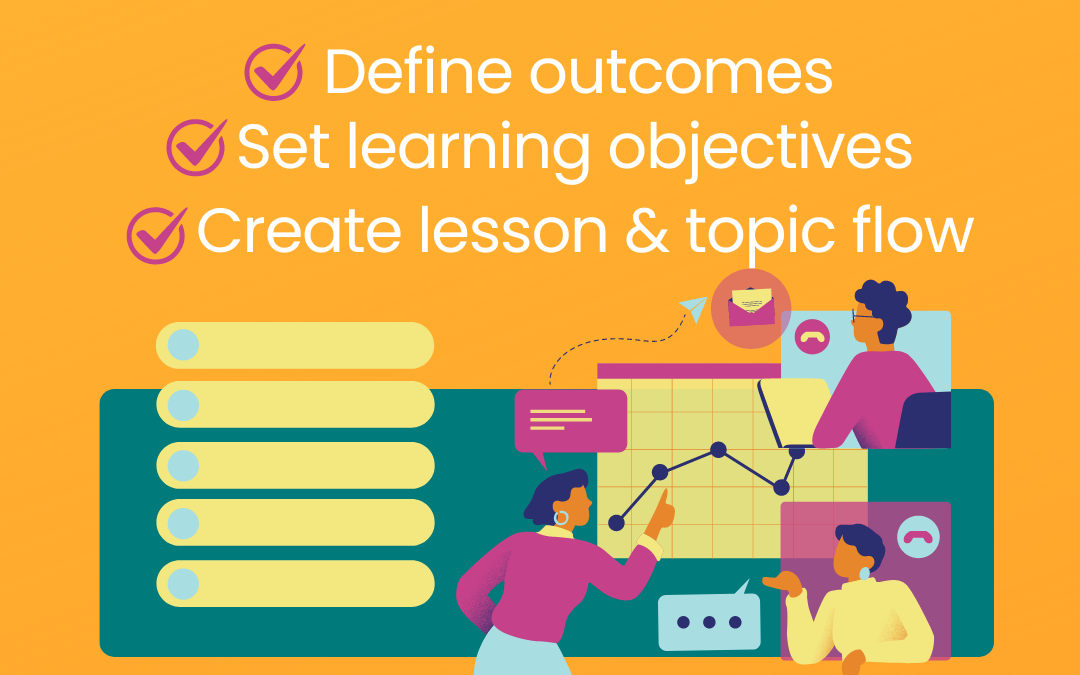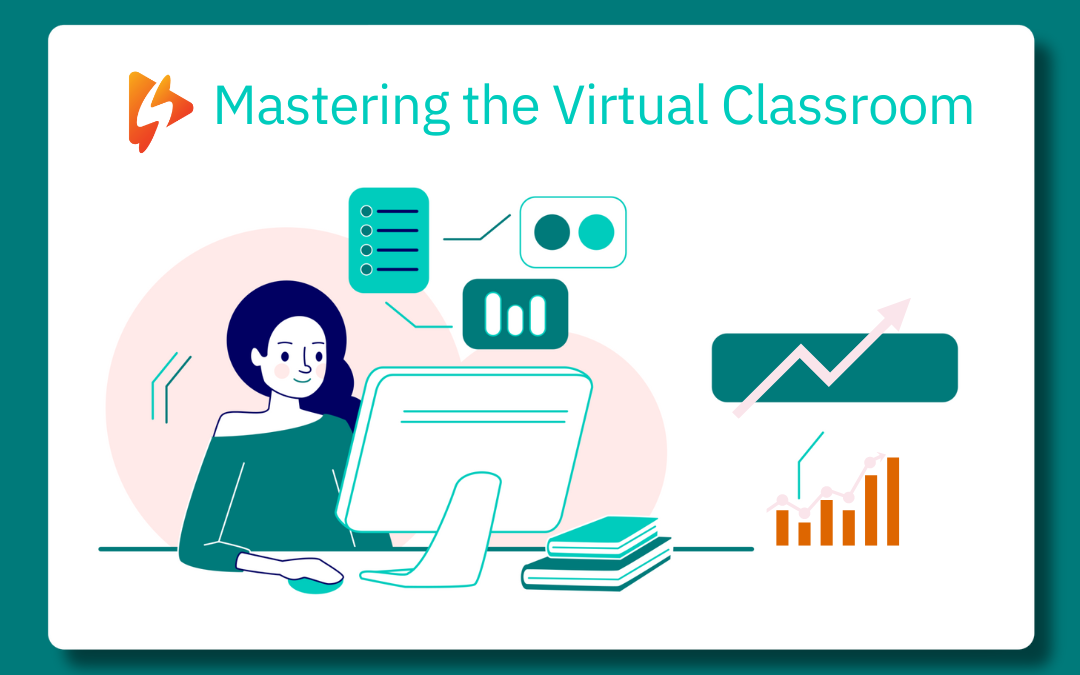Mastering the Virtual Classroom: How to Teach Online Classes Effectively
Are you wondering how to teach online classes effectively after transitioning from in-person learning to a virtual classroom? This guide walks you through setting up your digital learning space, structuring engaging content, and communicating effectively to keep students engaged.
We cover practical tools and strategies required for successful online instruction. Plus we’ll dig into marketing and pricing your courses.
In a Nutshell:
>> Online course content needs to be both well-structured and engaging. This can be done by outlining the order in which students need to learn concepts for them to make sense and by creating multimedia-rich lessons. Try to utilize all of the course features your course platform provides to keep students from zoning out.
>> Students will learn better when communication is emphasized. Provide ways for students to easily ask questions and create opportunities for students to collaborate with each other.
>> People need to know about your course so that they can take it! A streamlined marketing plan (and effective pricing strategy) will help you sell your course once it is created.
Navigating Learning Management Systems
Consider a Learning Management System (LMS) as your online classroom. It serves as the home for your course content and the hub of interaction with your students.
An LMS is vital in online teaching to:
– Deliver educational content in an extremely digestible format
– Share media like video lessons, documentation, notes, etc.
– Allow student contributions like feedback and questions on material
– Provide quizzes and assignments to assess efficacy of the course and student progress
– Track student progress via course and lesson completions and student profiles & analytics

Selecting the Right LMS for Your Needs
Choosing the right LMS is similar to setting up the perfect classroom for your students. It should be a place where students can easily access and interact with educational resources.
It’s important to choose an LMS that caters to your teaching style and tech-savviness as well.
You’ll want to consider the following essential features:
– Content management
– User management
– Reporting and analytics
– Scalability
– Mobile compatibility
– Customization options
– Assessment tools
Videos are the backbone of most online course content. You’ll want to specifically look into whether each LMS you’re considering provides video hosting. If they do, find out what limitations there are. We advise looking into a professional video hosting service to keep your valuable content secure and so that you have more customization and interactive options.
Define a realistic budget that also takes into account possible costs for content creation (like recording professional videos) and hiring help to set up your virtual classroom.
Utilizing LMS Features to Enhance Learning
After selecting the best platform for online courses, delve into its features to discover how they can amplify the online learning experience. A common mistake online educators make is not familiarizing themselves with all the features available so that they can make use of them.
Moreover, integration with external tools such as email marketing, social media scheduling, and payment gateways is crucial for enrolling new students.
A user-friendly interface with intuitive navigation is also important in an LMS to reduce the learning curve, minimize frustration, and improve overall engagement. Consider the user experience, aka what it will feel like to be a student.
Engaging Students Through LMS Platforms
In online learning, engagement is pivotal. The higher the level of student engagement, the greater the likelihood of learning and retaining the course material.
LMS platforms often provide collaboration tools such as course cohorts and discussion areas. These tools facilitate group work and enhance student engagement. Creating group assignments can promote peer interaction that is usually missing from virtual classrooms.
Quizzes, assignment uploading, gamification, and multimedia lessons are all features you’ll want to look into. If you have previously taught your course content in person, making updates so that you use the engagement features available will help your students stay focused now that they aren’t in a physical classroom.
Acquiring Necessary Technical Know-How
Most LMS’s are decently user-friendly and don’t require much tech-savviness. They also usually provide extensive how-to articles and tutorials for setting up your course. As you select your LMS, make sure you are aware of all of the resources they provide.
Of course, a good internet connection is a must. Plus, you’ll need some audio and video recording and editing equipment.
You can also hire help if you get stuck!
Crafting Engaging Online Course Content
Any course relies heavily on a well-structured curriculum. Spending time developing your video outlines and course outlines will be worth it. However, when it comes to online teaching, course content needs to be more than just well-structured— it needs to be engaging, especially on the best online teaching platforms.
This can be done by incorporating visual aids like graphics, slides, and interactive elements such as quizzes and assignments, which can significantly capture students’ attention and contribute to a more dynamic learning environment.
Furthermore, sequencing the course content logically helps students incrementally build their knowledge, enhancing understanding and memory retention.

Structuring Your Course Material
Structuring your course material is a key step in crafting an effective learning journey for your students.
Here are some tips to help you:
1 – Define the course’s overall purpose and establish clear learning outcomes for each lesson.
2 – Include learning objectives at the start of each module to help students set reasonable expectations of the course material.
3 – Create a coherent flow from foundational lessons to advanced topics to ensure a logical progression. Writing down a course outline will help you put lessons in the right order.
A comprehensive syllabus should include the following information:
– Contact information
– Course objectives
– Course materials
– Grading criteria
– Class policies
– Guidelines for late assignments
Additionally, it is important to establish a clear course schedule and set clear expectations for students to ensure that they understand their responsibilities in the course.
Incorporating Interactive Elements
Incorporating interactive elements into your course can help keep students engaged.
Here are some ways to do that:
– Use multimedia such as infographics and videos to improve the visual appeal
– Incorporate interactive elements such as quizzes, live lessons, and discussion boards
– Include in-video questions to ensure students are paying attention (this is an advanced feature that some course platforms and video hosts provide)
Remember, engaging course content not only captivates your students but also enhances their understanding of the course material.
Tailoring Content to Diverse Learning Styles
Online courses allow teachers to provide materials that accommodate diverse learning styles, offering every student the opportunity to succeed. To cater to different learning preferences, use a range of content types and instruction styles.
Here are some strategies to enhance the online learning experience:
– Upload video and audio files of your lessons for visual and auditory learners
– Provide written transcripts for reading learners
– Use infographics, charts, or diagrams to engage visual learners
– Create a variety of assignment types to test knowledge retention
By implementing these strategies, you can allow them to learn in the way that works best for them.
Effective Communication in the Online Classroom
Just like any successful teaching endeavor, online teaching also hinges on effective communication.
Some ways to facilitate effective communication in online teaching include:
– Setting virtual office hours
– Posting discussion board questions
– Scheduling calls with students one-on-one
– Staying on after a live class to answer questions
These methods help students form connections with their instructors and address their concerns.
Providing timely feedback to students is crucial for pinpointing areas needing additional instruction and identifying their areas for potential improvement.

Establishing Communication Channels
Due to the challenges associated with virtual learning, it’s important to initiate communication with students at the start of the course. This sets a proactive tone and encourages students to actively engage and reach out with their questions.
By setting aside weekly virtual office hours, teachers can be accessible and address the unique learning challenges faced by students in the virtual environment.
Don’t forget that effective communication requires both speaking and listening. Make sure you’re not just imparting knowledge but also listening to your students.
Encouraging Online Discussions
Facilitating online discussions effectively stimulates student engagement and interaction. Here are some strategies to consider:
1 – Ask questions that require critical thinking and require students to answer the questions and leave a thoughtful comment on another student’s answer.
2 – Encourage casual discussion with non-course related questions, like, “What is your favorite TV show?”
3 – Acknowledge diverse perspectives and use them as a jumping-off point for further discussion.
By implementing these strategies, you can promote critical thinking and create a collaborative learning environment.
For larger classes, the use of smaller group discussions through virtual breakout rooms can improve student participation and discussion quality.
Open and active discussions not only facilitate learning but also foster a sense of community among students.
Providing Timely Feedback
Timely feedback from instructors can help a student succeed by providing accurate information while lessons are still fresh in their minds. In a virtual classroom, feedback is essential not only for correcting student misunderstandings but also for motivating and engaging them in the learning process.
To overcome barriers to timely feedback in the virtual classroom, instructors can utilize automated grading tools for immediate responses and set aside regular times to provide personalized feedback.
Teachers can create a more positive experience by providing positive feedback as well as explaining where there is room for improvement. Be sure to point out what students are doing well.
Promoting Interaction and Collaboration
Looking for ways to increase interaction and collaboration not only enhances the learning experience but also fosters a sense of belonging among students.
It can take a little extra effort for instructors to set up group learning opportunities. Providing students with ideas on what software to use to collaborate can reduce frustration.
Utilizing mind-mapping tools online allows for a visual and interactive way to organize ideas and connections, aiding students in developing group projects and explaining complex concepts.

Facilitating Group Projects
Group work in virtual classrooms can range from informal, collaborative activities to formal assignments that necessitate a collective submission from the entire group.
Students can collaboratively work on writing projects and slide presentations in real-time using cloud-based software like Google Drive, which ensures all participants have access to the most recent version and can contribute equally.
Accountability measures are crucial for ensuring that all members participate and contribute to group assignments in online classes.
Fostering Peer-to-Peer Learning
Peer-to-peer learning can take the form of peer tutoring, accountability partners, or a class wiki.
A wiki can serve as a dynamic platform for students to cooperatively build papers and share knowledge. Wikis can be used for compiling a glossary of course terms, creating a group portfolio, or conducting a group research project.
Improved learning outcomes often occur when students are given opportunities to learn from each other.
Utilizing Breakout Rooms
Facilitating small group discussions and activities within a virtual classroom is easily done using breakout rooms. These are sub-rooms that can be created within a virtual classroom.
Instructors can:
– Assign students to breakout rooms manually or automatically
– Move between rooms to monitor and participate in discussions
– Time breakout rooms with a countdown feature to let participants know when the room will close and return them to the main session
– Broadcast a message to all breakout rooms, which can be used for announcements or to provide students with instructions
Regularly changing group composition in breakout rooms can offer students exposure to different perspectives and keep the dynamic fresh. Facilitating follow-up discussions after breakout room activities can help students reflect on what they have learned and understand how it fits into the larger course context.
Measuring Success and Getting Feedback
Quizzes, graded assignments, and personal assessments can all play a part in tracking the progress of your students throughout the course.
progress of your students throughout the course.
Informal surveys and polls are effective tools for assessing the course material and your teaching style from the perspective of your students.
For the sake of continuous improvement, it’s helpful to measure the success of your online teaching efforts. Clear goals, learning objectives, expected outcomes, and success criteria give a structure for evaluating the effectiveness of online teaching.
Tracking Student Progress
A key component of measuring the success of your online teaching efforts lies in tracking student progress. It provides a framework for understanding how learners are managing with the course content.
By analyzing student performance data through quizzes and graded assignments, educators can adapt their teaching methods to offer the necessary support where needed. It also shows students where they are at and how they can improve.
Conducting Surveys and Polls
Gathering feedback from your students can be effectively done using surveys and polls. They can provide valuable insights into their learning experience and help you improve your course content and possibly adapt your teaching style.
Surveys are invaluable tools to collect feedback from students on how to improve their experience. Remember to always explain to students the purpose of the survey, to let them know that you take their feedback seriously, and to never take their feedback personally.
Polls can be a quick method to assess student opinions on specific assignments or lectures. You can also find out how your students feel about group projects, the use of multimedia elements (or lack thereof), and what would make the course content more engaging.
Remember, feedback is a two-way street. So, make sure you not only provide feedback to your students but also take their feedback into account.
Adapting Based on Feedback
Consider feedback as a gift, offering valuable insights to enhance your online teaching methods. Implementing changes based on student feedback is essential for refining your teaching style and improving students’ learning experiences.
To measure the success of your online teaching, you can:
– Compare the outcomes of online teaching against goals set before the course started
– Use student feedback and evaluations to assess the effectiveness of your teaching methods
– Analyze student performance and progress to determine if learning objectives are being met
Asking for feedback and incorporating it benefits online learners and will help you be a more effective educator.
Marketing Your Online Classes
Just like any business, online teaching thrives on effective marketing. No one can take your course if they don’t know it exists.
A sales funnel is crucial for attracting and converting potential customers for an online course.
Let’s look at how you can grow an online teaching business and convert passive followers into paying customers.

Developing a Solid Marketing Strategy
An overall marketing strategy will guide your marketing activities and ensure that you’re not wasting time and energy.
Establishing a unique selling point is vital to stand out among numerous online courses. Research other courses teaching on the same topic. What makes yours different?
To market an online course effectively without an existing audience, you can:
– Ask family and friends to share your course with others
– Find affiliates who will market your course to their existing audience in exchange for a commission on sales
– Run Facebook ads
– Post educational content on Pinterest to drive traffic to your website and email list
Leveraging Social Media and Content Marketing
Social media and content marketing can be potent tools for the promotion of your online classes.
Opting for the appropriate social media channels like Facebook, Instagram, and LinkedIn is crucial in targeting the right audience for course marketing. Find out where your target audience is most active and focus your efforts on that social media platform.
To optimize engagement with potential students, here are some strategies to consider:
– Schedule social media posts for when your target audience is most likely to be online
– Use hashtags to increase the discoverability of course promotions
– Engage in trending topics to reach a wider audience
– Run contests or giveaways to incentivize engagement
– Respond promptly to comments and messages to build meaningful relationships and foster a dedicated online community
These cost-effective methods can significantly increase the discoverability and engagement of course promotions.
Guest blogging on reputable blogs within the niche and pitching to be a guest on relevant podcasts can extend reach, build brand awareness, and establish your reputation as an expert.
Paid advertising on social media platforms can effectively increase brand visibility and lead potential customers to sales conversions. Providing a free course preview or a free version can build trust with potential students, encouraging interest and sign-ups for the full course.
Leveraging social proof by showcasing testimonials can enhance course credibility and attract more students as well.
Implementing SEO Best Practices
SEO, or Search Engine Optimization, is a major player in the arena of online marketing. Implementing SEO best practices can help your online course reach the top of search engine results, making it easily discoverable by potential students.
Effective SEO practices involve:
– Utilizing keywords
– Building backlinks
– Improving website speed and performance
– Creating high-quality and relevant content
– Using alt tags for images
– Implementing a mobile-friendly design
– Ensuring a user-friendly website navigation
By prioritizing SEO, educators can ensure that their online courses get seen more often.
Pricing Strategies for Online Courses
When it comes to marketing your online course, knowing how to price your online course is crucial. It’s a delicate balance between making your course accessible to students and ensuring that you’re compensated fairly for your time and effort. Online courses may be worth more than educators initially credit them, reflecting the accumulation of work, life experiences, learning, and education.
Setting a course’s price involves balancing:
– Quality
– Student expectations
– Competition
– Revenue goals
– Factoring in production or marketing expenses
Pricing a course exceedingly high can deter people from purchasing, but a well-valued course priced at $200, for instance, could potentially yield an annual income of $73,000 if one course is sold daily.
Alternatively, pricing a course too low can cause people to assume that it is not high quality.
Determining Your Course’s Value
Determining the value of your course is a prerequisite to setting its price. The value of a course is significantly influenced by the market demand for the topic it covers.
Remember, the perceived value of your course plays a crucial role in how much students are willing to pay for it.
Analyzing Competitor Pricing
Gaining an understanding of what similar courses are priced at by your competitors can aid in competitively pricing your course.
Collecting data about competitor pricing involves looking at similar online courses and their pricing structures, keeping in mind factors like course length, content quality, and instructor reputation. A strategically set price that balances competitiveness with fairness can make an online course more appealing to potential students, impacting enrollments and overall success.
Offering Discounts and Packages
Attracting more students to your online course can be effectively achieved through offering discounts and packages.
Offering limited-time discounts when launching a new online course can create a sense of urgency and entice learners to make a purchase. Limiting the number of times a discount code can be used can also create a sense of exclusivity and urgency.
Rewarding loyal customers with discounts or bulk purchase deals can enhance their sense of appreciation and potentially foster long-term loyalty.
Bundling courses can increase sales by combining popular and less popular courses and offering them at a discounted rate. When applying discounts, it is important to consider the profit margin and ensure that the discount does not significantly diminish profits.
Summary
Teaching online is an art that requires mastering multiple aspects—from setting up a conducive digital classroom to crafting engaging course content to promoting interaction and collaboration among students to marketing your courses.
By implementing the strategies in this article, you can ensure that your online teaching endeavor is a success.
Frequently Asked Questions
How can I teach my own online course?
You can teach your own online course by choosing a topic, outlining content, selecting a course platform, creating multimedia-rich lessons, and building a sales page to start enrolling students. Yes, it’s a lot of work. But you can do it!
Check our our own Spotlightr blog series on creating your own course.
How can I make my online course content engaging?
Incorporate a variety of multimedia elements, like audio, video, quizzes, graded assignments, discussion boards, and live lessons. Organize the content logically so that information builds on itself as students progress through each lesson. Your audience will find the course more enjoyable and impactful.
How can I communicate effectively in the online classroom?
Establish clear communication channels such as virtual office hours. Be proactive in reaching out to your students to find out if they have questions. Do a live Q&A session where students can submit questions they want you to answer.
How can I gain credibility as an online teacher?
Establishing credibility in the online teaching space can be accomplished by:
– Gaining testimonials from students (video testimonials are the gold standard)
– Sharing free helpful content
– Deepening trust through live streams
– Collaborating with other experts in similar niches
Spotlightr Video Hosting For Your Course
Discover why Spotlightr is the #1 choice for course creators and e-learning professionals.
Register for a free 2 week trial, no credit card required.

